We now have many mummies and skeletons, mostly from western South America, that are sort of human-like, but don’t fit into any mainstream history of humanity. There are so many congenitally elongated skulls that they must correspond to a subspecies, perhaps with dominant relationship to people with heads we regard as normal. That would help explain the practice of artificially deforming heads of infants. There are at least 8 reported fully-preserved mummies with mixed features from humans, other primates, birds and reptiles. This article is about 3 of these, known as Ata (from Chile), Josefina, and Maria (from Peru).
Some Most scientists tend to throw anomalous data out so they can get on with the business of refining the theories that cover most things well. We need scientists like this. I only take issue when they try to silence the rest of us, crying “fraud” or “hoax” or “case closed” when they have not engaged with facts on the ground. If you use a search engine to research the mummies of Nasca (Nazca), you will be directed to fact-checkers and popular articles that assure you there’s nothing to see here. If you read the scientific literature on the Atacama mummy, you will find Garry Nolan’s conclusion that it represents a human fetus with an unlikely history and an even more unlikely genome, including 3 million SNPs — about a thousand times the expected mutation rate. If you are willing to swallow this hippopotamus, why not other unlikely scenarios?
The Atacama Mummy
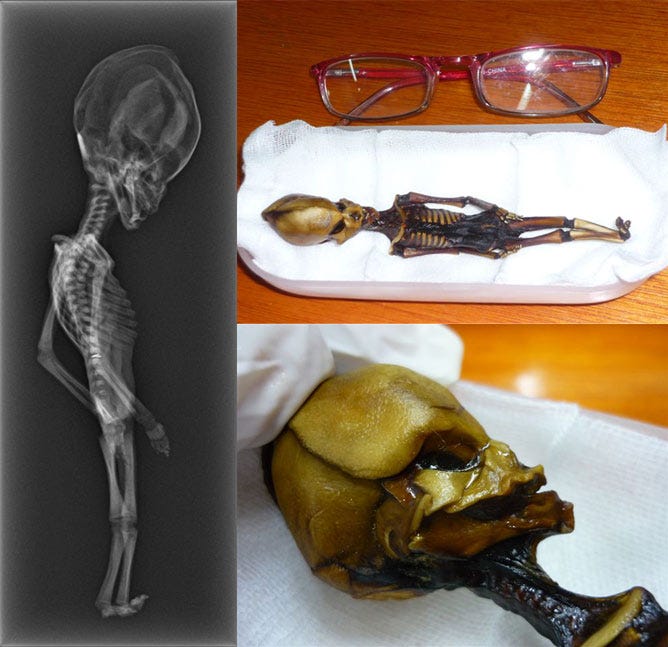
Photos from Science Magazine, credited to Garry Nolan.
Ata’s history is murky. Wikipedia says the 6-inch mummy first appeared in 2003, and found its way into the scientific world only a few years later. Articles in 2008 noted that the pointed head and huge eyes look like a comic book ET. But by 2013, we had Nolan’s DNA report, and Science Magazine together with all the mainstream science reports declared
To the chagrin of UFO hunters, Ata is decidedly of this world. After mapping more than 500 million reads to a reference human genome, equating to 17.7-fold coverage of the genome, Nolan concluded that Ata “is human, there’s no doubt about it.”
I have a lot of respect for Nolan. He is not only highly credentialed, but a careful and open-minded scientist who has reported personal experiences with UFOs. He was given only a tiny bone sample from Ata. I imagine he was pressured to report “human, no doubt about it” in the face of the improbable string of coincidences that were necessary to support this conclusion. Certainly, there are other stories that can be told that are no more improbable.
Ata has an enlarged head with a pointed skull unlike any human. There are two less ribs than humans have. The size of the mummy is consistent with an 18-week fetus, but an 18-week fetus has different proportions and is not fully physiologically developed, whereas the Atacama mummy shows signs of development, especially in the joints, that is consistent with a child who has walked freely for at least several years.
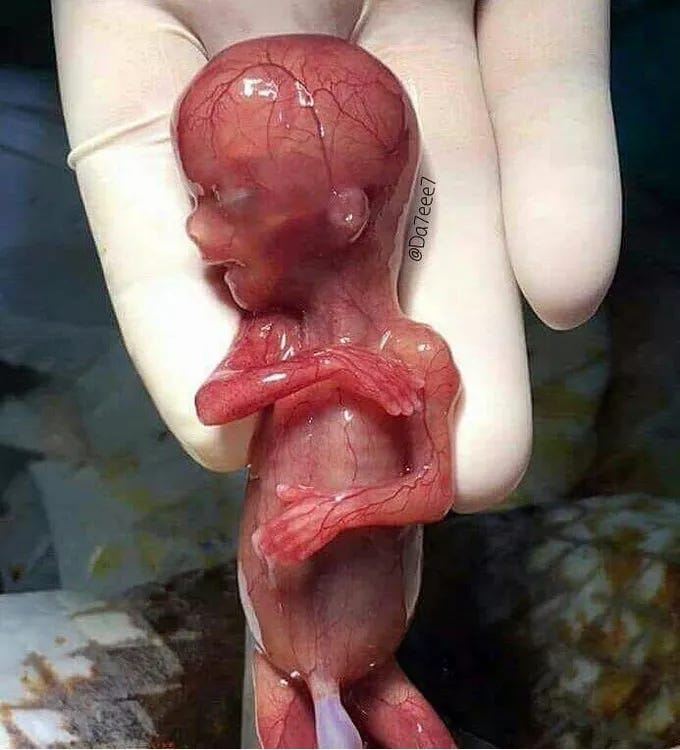
Elongated skulls
There are many elongated skulls, which seem to be of two types. The uninteresting ones were deformed by strapping infant heads to boards. But the other type, the congenitally elongated skulls, are clearly distinguishable. In this case, the size of the skulls is larger; binding the head can change the shape and can decrease the volume, but cannot increase the volume. The elongation at the back of the skull cannot be produced by binding.
Congenitally elongated skulls typically lack a sagittal suture. In humans and other primates, the front of the skull is in one piece, but the back of the skull has a left and right half that are fused in adults, but usually with some vestiges of a scar remaining. This scar is what is referred to as a sagittal suture. It is missing in the elongated skulls
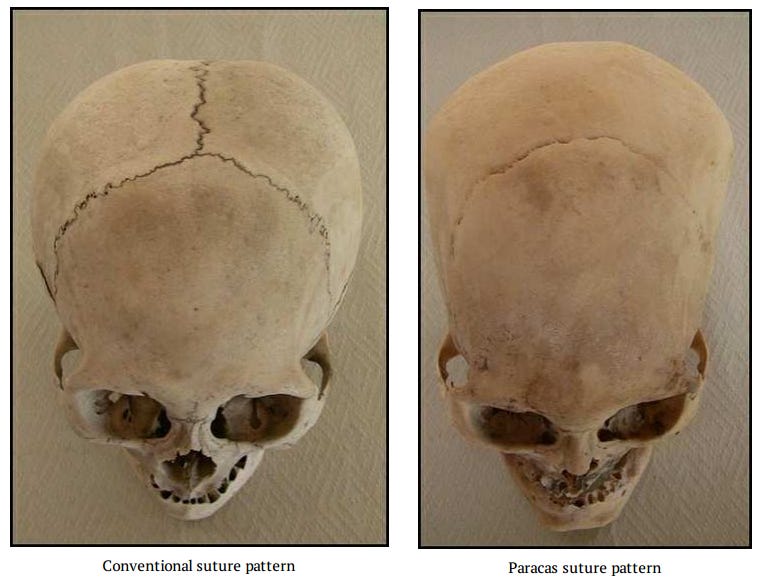
Aside from the west coast of South America, such skulls have also been found in Eastern Europe. Elongated skulls are associated with red hair, which is found in European but not South American native populations. Brien Foerster’s theory is that there was a migration from the Black Sea area to South America some time between 3000 and 2000 years ago. Others say the migration went the other way. But in either case, we must accept global navigation in an age when (conventionally) bronze age cultures only had small wooden sailships.
Foerster’s book
Foerster video
Foerster’s hypothesis is that people with elongated heads were visitors who had superior intellect or knowledge or powers, so that they became leaders or even “gods”. Native peoples who came under the influence of these visitors developed the tradition of head-binding because the elongated skulls were associated with power and nobility. This sounds reasonable to me.
Where did the people with elongated skulls originate? Foerster mentions but dismisses the possibility that the long-skull people were hybrids with extraterrestrials. Where are the descendants of long-skulled people today? Both the appearance and the disappearance of this genetic variation seem mysterious. There are many anecdotal accounts of abductions, mutilations, and genetic experimentation, and Dr John Mack, among others, has made a case that these are credible. Whether the abductors are from another planet or are a race apart from publicly-known humanity, living apart in secret enclaves, is not possible to know — both hypotheses are outside the bounds of mainstream science. It seems reasonable to me that a race of elongated skulls may be connected to abductions and exotic hybridization projects, but that doesn’t necessarily mean that people with elongated skulls exist today.
The Paracas/Nazca regions of Peru where these skulls have been found is also associated with ancient geoglyphs. These are line drawings, stick figures, and geometric designs that are drawn into the ground on a scale of hundreds of meters. They are thousands of years old, but they can only be perceived from the air. This has been another source of speculation about extraterrestrial intervention.
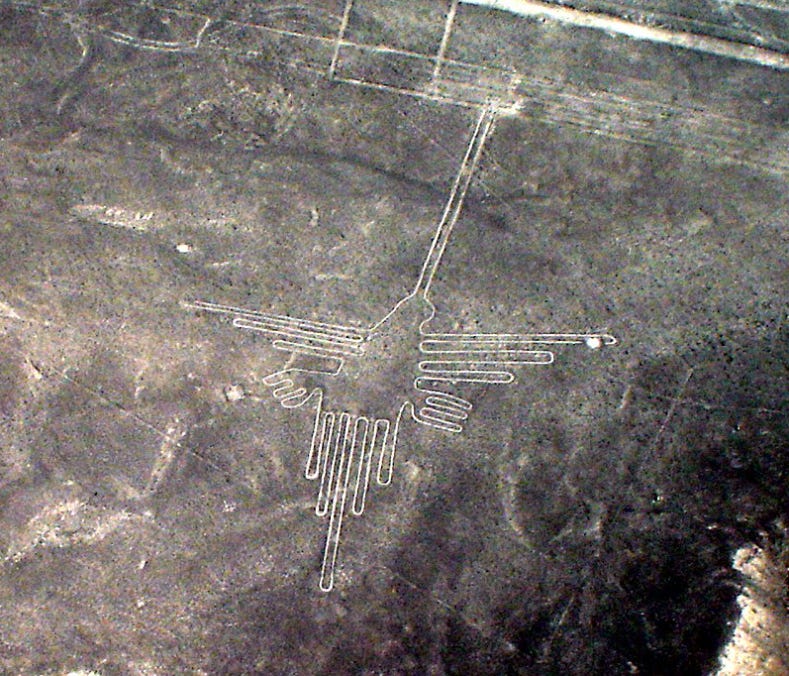
To my knowledge, there has been no genetic analysis of the ancient skulls, which could tell us whether they are humans with small differences that accounts for skull shape, or perhaps they include more extensive genetic differences from modern humans. Genetic testing might also connect them to a region of ancestry.
Puma Punku, Bolivia is on the border with southern Peru. Here are two skulls from their museum.
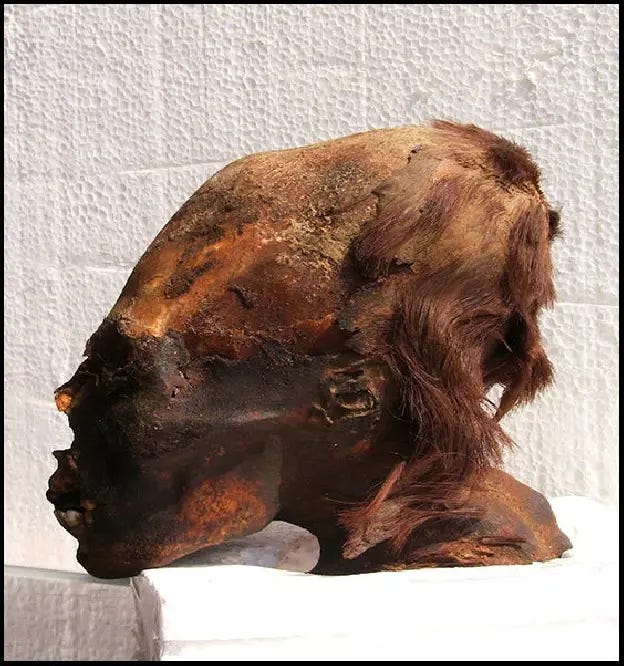
Note the red hair.
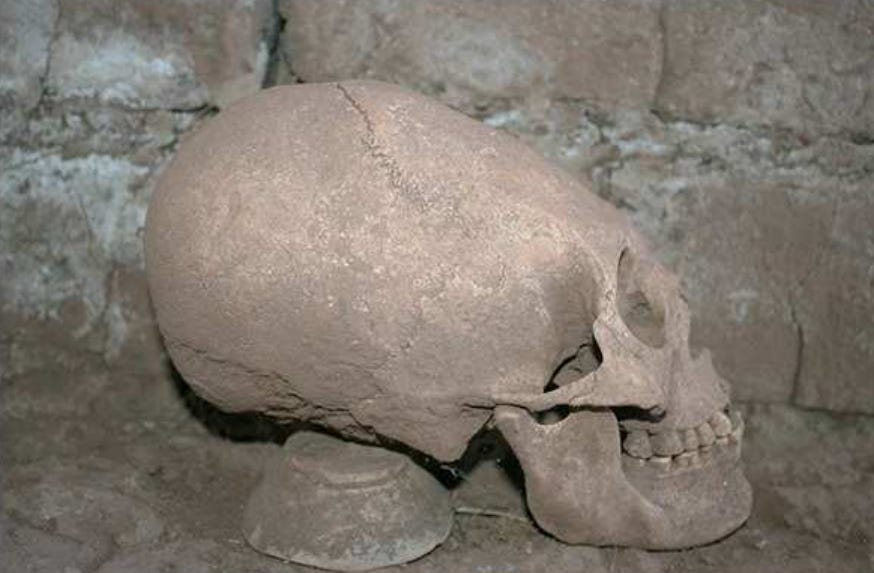
There are many more.
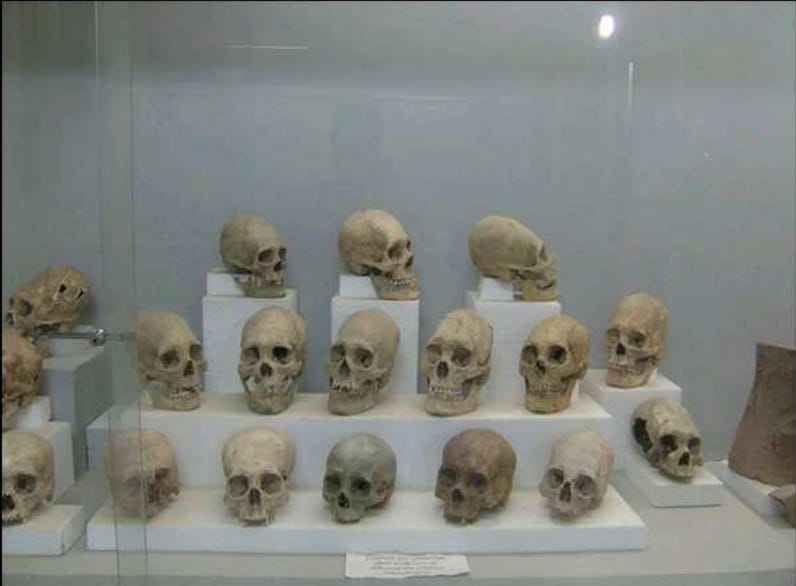
Conference in Lima, 2018
Biologists who had analyzed Peruvian mummies made a report to the Peruvian Congress in November, 2018. Their expert testimony is recorded on videos available here. They identified three types of mummies, which they labeled “hybrid”, “reptilian” and “insectoid”.
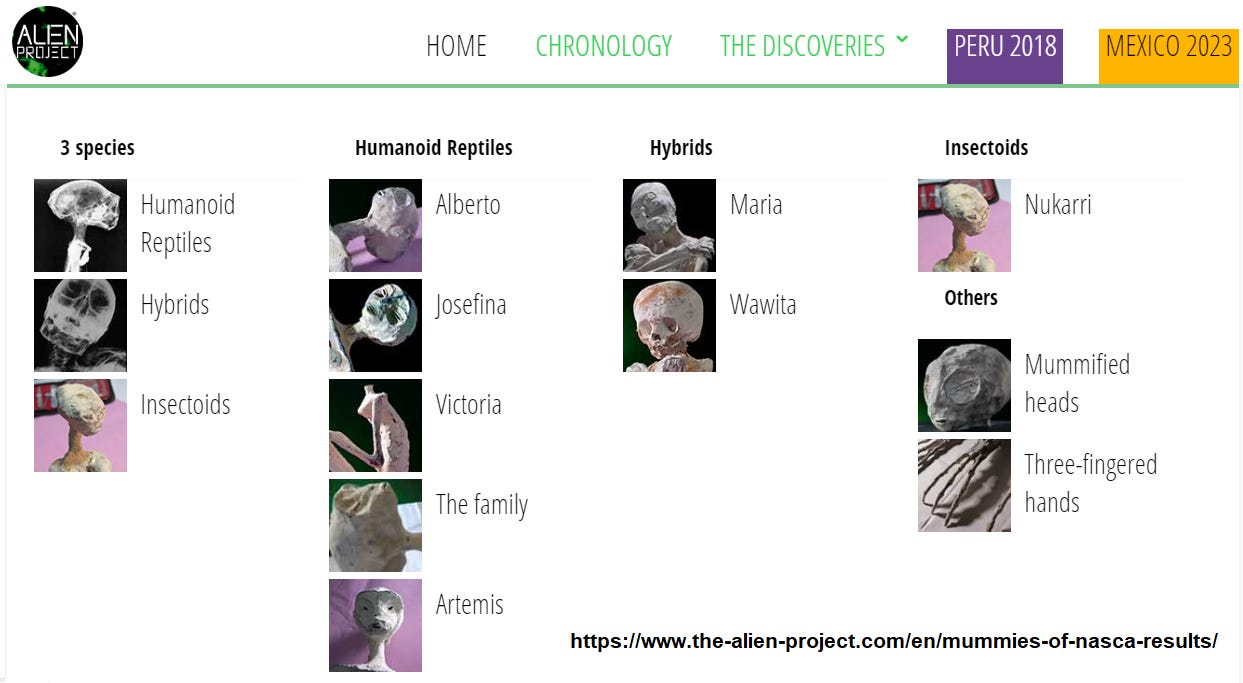
Maria
This is the nickname of one of the mummies. The following are excerpted from the report of Ricardo Rangel Martinez.
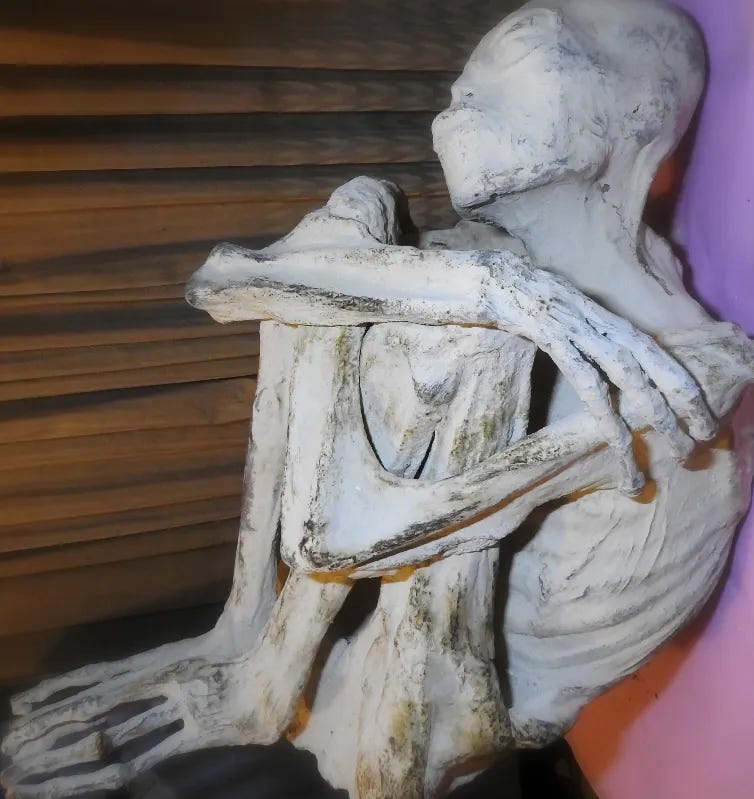
The mummy Maria has roughly human anatomy. She is frozen in fetal position by an embalming technique involving diatomaceous earth. She has the ribs and appendage bones of other primates, but she has only 3 fingers, elongated and emanating from a single wrist bone, where primates have 5. The brain is larger than a human. There are no breasts and no navel, no external ears.
She is classed as “hybrid” based on DNA analysis. Roughly ⅓ of her DNA is human, ⅙ from other species, and ½ defines identification. Carbon dating indicates an age of about 1700 years.
X-ray imaging gives a detailed view of her 3D anatomy in this video. Martinez claims that similar mummies have been found in Mexico, near Teotihuacan.
Josefina
This mummy (and several like it) are just two feet tall, fully grown. For comparison, African Pygmies are typically 4 – 5 feet. Laron syndrome dwarfism is a genetic variant found most frequently in Ecuador, and results from an impaired gene for growth hormone. Affected people are all more than 3 feet tall.
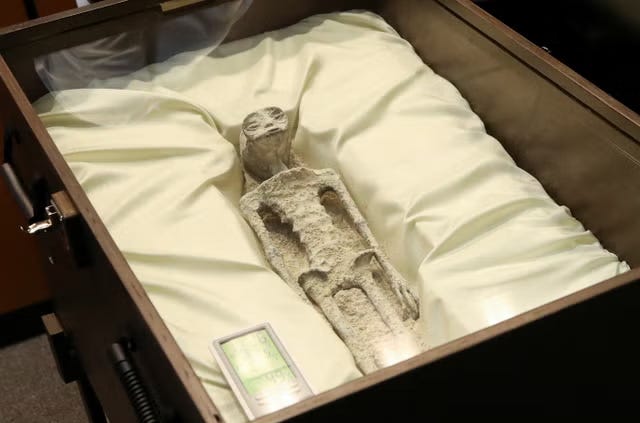
According to the testimony of Jose de la Cruz Rio-Lopez, Josefina is C14 dated at about 1800 years old. She was mummified with resin in the skin and diatomaceous earth. The head is almost cylindrical in shape. The skull structure is unlike any known vertebrate. There are holes in bone behind the eyes in places where reptiles but not mammals have holes. There is a pig nose and a small mouth with no teeth. Perhaps she ate only liquids.
She has a retractile neck and scaly skin, like a reptile. Her forearms and lower legs each have a single bone, like a bird rather than a mammal (radius+ulna). Her bones are hollow, like a bird. Each hand has three fingers, emanating from a (fused?) carpal bone.
(Note: there is a lot of ancient art in Peru portraying animals or humanoids with 3 fingers.)
A furcula means the fusing of the two collar bones (clavicles) into a bone that goes across the body. It is characteristic of birds today. At the dinner table it is the “wishbone”. It is also found in fossils of some non-avian dinosaurs, but no mammals or reptiles today.
Josefina has three eggs inside her. They are oval and symmetric, like reptile eggs, without a big end and a small end.
Her spine has 31 vertebrae, like a human. She has 23 pairs of chromosomes like a human (and no other primate). She has 11 ribs, compared to humans’ 12.
Inside her chest is a metal implant, an 85% copper alloy.
Two stories
What do we make of these beings that are human-like, but with marked differences? How can we accommodate them in some modified version of conventional anthropology?
Story #1
They are evolved on another planet, far from Earth. They come here with their advanced technologies, which may be physical or mental, and they have been visiting for at least thousands of years.
They have evolved to be like us because of convergent evolution. Life requires very special laws of physics that make possible a particular kind of chemistry. There is no other way to make life aside from the DNA, proteins, lipids, and sugars that are the basis of life we know. Hence we find that their biochemistry and even their morphology, though evolved far from Earth, is quite familiar to us.
Story #2
They are evolved on planet Earth, and diverged from humans millions of years in the past. There were and are many races of humanoid species on the Earth. Some live underground, and have hidden from us in the way that the Morlocks hid from the Elois (H.G. Wells). But they have technologies far beyond ours, and they fly in UFO vehicles that we identify as extraterrestrial because their technology seems exotic and we don’t know any better.
Why the reptilian and avian features? Could it be that there were large-brained, civilized reptiles in the age of the dinosaurs who had their own technologies?
I’m open to Stories #3, #4, and #5 in your comments.
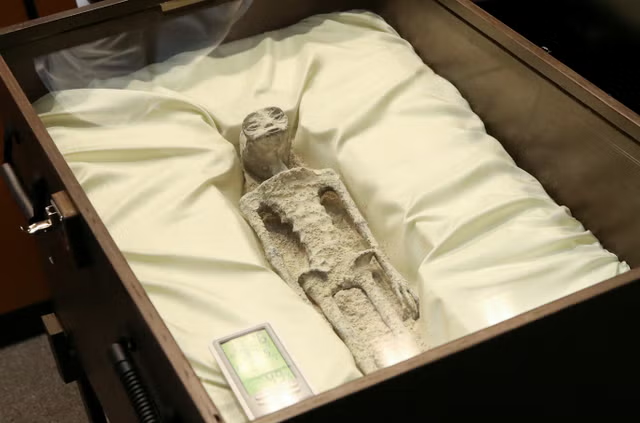
Before most of you were born, in the 1950’s Art Bell’s radio program discussed this subject. Google art bell